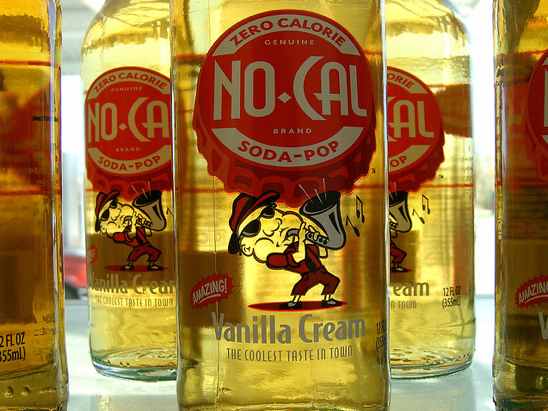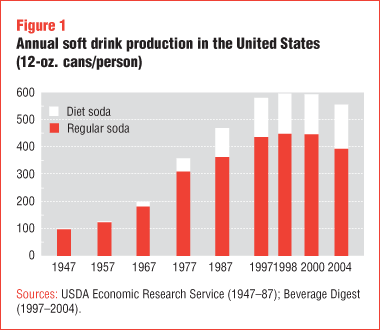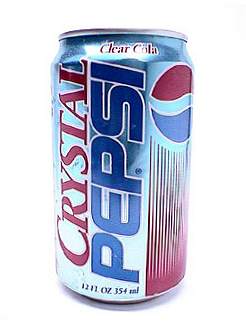Diet soda is a no brainer. We drink it to avoid the sugar calories from regular soda, right? But do the benefits of consuming fewer sugar calories outweigh the risks of consuming artificial ingredients?
What is diet soda?
Good old 1952. TV debuted in Canada and the first diet soda was sold. It was a ginger-ale, called No-Cal Beverage. The first diet cola was released seven years later. These beverages were sweetened with saccharin (think: Sweet ‘N’ Low) and designed for people with diabetes, not people limiting sugar and counting calories.
Oh how times have changed.
Creating a diet soda has long been of interest to food manufacturers and consumers, since the sugar in regular soda carries many calories with no nutritional value and increases the risk of cavities. In theory, since sugar-sweetened sodas provide such a huge number of calories to the American diet, one would think that replacing these sugars with a non-caloric sweetener would result in some major weight and health changes. They’ve changed all right: since the introduction of non-caloric sweeteners, weight has increased and health has arguably diminished.

Why is diet soda so important?
In the 1990s, diet soda consumption was stable but started to increase in 2002, rising from 4.8 ounces per person per day to 5.6 ounces in 2004. (Homeboy who lives down the street and slurps the 44 oz Big Gulp on the way to work each morning skews those numbers for all of us.) 86% of Americans use diet products, including low-calorie, reduced-sugar, or sugar-free foods and beverages. In the U.S., consumers spend about $21 billion per year on these drinks. By comparison, these same consumers only spend $14 billion on organic food.

What you should know about diet soda
Have you ever heard of Diet Coke? Me too. Let’s break down the ingredients. It contains carbonated water, caramel color, aspartame, phosphoric acid, potassium benzoate, natural flavors, citric acid and caffeine. We’ll take them one by one.
Carbonated water
This is water dissolved with carbon dioxide. Poof, we have carbonic acid. While it doesn’t do much for enhancing health (and in fact, it’s part of the process of respiratory excretion as the body tries to rid itself of carbon dioxide), it’s great for getting rid of coffee stains.
Caramel color
Without this, cola wouldn’t be brown and happy hour beers wouldn’t be gold. Caramel color is the most commonly consumed food coloring ingredient in the world. It provides no flavor, only color. It’s produced by heating carbohydrates (like fructose, dextrose, or invert sugar) with a food-grade acid (like sulfuric, phosphoric, or citric) to break the sugar bonds. Or the carbohydrates can be heated along with salts (like ammonium, sodium, and bicarbonate). Polyglycerol esters of fatty acids are also used as anti-foaming agents during the production of caramel color. Think of caramel color as burnt sugar. As you might assume (since it’s used in diet soda), caramel color is soluble in water.
Negative health consequences of caramel color are unlikely as long as someone doesn’t consume more than 200 mg/kg of body weight. Still, there is the potential of an allergic reaction, but that comes with many food ingredients. Caramel color has a very low caloric content, and most of it is not absorbed in the gastrointestinal tract. If you want to know what life would be like without caramel color in diet colas, set your time machine for the early 1990s and get familiar with Crystal Pepsi.

Aspartame
Aspartame, an artificial sweetener that’s composed of aspartic acid, phenylalanine and a methyl ester, is a chemical, not a naturally occurring compound. It was discovered in 1965 by a chemist named G.D. Searle. (See our Research Review on Splenda for more on the discovery of artificial sweeteners.) He was actually studying a treatment for gastric ulcers at the time. 16 years later, aspartame received limited sanction, and in 1983 was approved for use in diet sodas. It’s the most popular sweetener in the U.S. food industry (as of 2007). With more than 90 countries having approved aspartame, its use is widespread. Brand names for aspartame include Equal, NutraSweet and Tri-Sweet.
Aspartame exceeds table sugar sweetness by 200 times. Since it still contains 4 calories per gram (as does table sugar), this intense sweetness allows much less of it to be used in diet sodas. The major vehicle for aspartame consumption in North America is diet soda. The Acceptable Daily Intake (ADI) is set at 50 mg/kg in the U.S. and 40 mg/kg in Europe and Canada. For an 80 kg person, this is between 3,200 and 4,000 mg per day. The following chart shows the aspartame content of typical products.
| Product category | Serving size | Aspartame content |
|---|---|---|
| Carbonated soft drinks | 12 ounces | 180 mg |
| Gelatin dessert | 4 ounces | 95 mg |
| Powdered soft drink | 8 ounces | 120 mg |
| Hot chocolate | 6 ounces | 50 mg |
| Pudding | 4 ounces | 25 mg |
| Frozen novelty | 2 – 3 ounces | 50 mg |
| Fruit drink (10% juice) | 6 ounces | 70 mg |
| Breath mints | 1 mint | 1.5 mg |
| Vitamins | 1 vitamin | 4 mg |
| Ice cream | 4 ounces | 50 mg |
| Yogurt | 8 ounces | 124 mg |
| Gum | 1 stick | 6-8 mg |
Source: The NutraSweet Company
Before you look at that chart and try to fathom how anyone could consume enough aspartame to cause health problems, a study on patients with disordered eating found them consuming up to forty diet sodas (12 ounces each), 30 pieces of sugar free gum, and up to 350 packets of artificial sweetener per week.
After we swallow a gulp of diet soda, aspartame makes its way to our small intestine, where it’s broken down into its components: aspartic acid, phenylalanine and methanol. These substances can then enter the blood. Phenylalanine may accumulate in the bloodstream, but it’s difficult to predict how high doses of phenylalanine will react, as animal research models metabolize it differently.
Methanol is further metabolized into formaldehyde and formic acid. But before you call the poison control center, remember that we also get methanol from figs and orange juice (along with other foods), and we get formaldehyde from scary substances like apples, carrots and coffee. Hope you covered the kid’s eyes for that one. Acidosis can occur with significant blood levels of formic acid.
Research in animals provides evidence that aspartame has a strong cancer causing and brain damage potential, with the dosage tested approximated at the ADI for humans. Human research shows that consuming 2 to 100 mg/kg of aspartame doesn’t influence cognition and behavior.
In 2007 and 2008, scientists confirmed and reinforced aspartame’s varied cancer causing potential at a dose level close to the amount suggested for humans. Moreover, when exposure begins during fetal life, the chances of cancer are enhanced. With this being said, no reliable epidemiologic study has been undertaken.
There was a 98 page review about aspartame in a 2007 Critical Reviews of Toxicology (published shortly before the aforementioned research was released). The review indicates that the more aspartame we consume, the greater potential for health to go awry. In saying that, the authors concluded that no credible link exists between consumption of aspartame (at levels estimated in the human diet) and conditions related to the nervous system and behavior. Also, it appears that overall evidence is limited on its cancer causing and rebound hunger potential.
Aspartame has 92 side effects listed by the FDA and use by pregnant women and young children is discouraged. Hmmm, if it’s not safe enough for the pregnant mom down the street, is it safe enough for everyone else?
Phosphoric acid
This stuff has a tangy, sour taste and slows the growth of mold and bacteria. It’s a bit different from straight phosphorus as it binds with magnesium and calcium in the digestive tract to form salts that aren’t absorbed. This may lead to a decline in the materials needed for bone deposition. So as you might assume, studies have associated phosphoric acid consumption to a lower bone density. Still, other studies have found that phosphoric acid has no impact on calcium excretion.
Diet colas, which generally contain phosphoric acid (non-colas usually don’t), have also been linked to kidney disease and kidney stones. Two or more colas per day more than doubled the incidence of kidney disease in one study; non-colas didn’t have the association. While phosphoric acid doesn’t do much to improve our health, it’s exceptional for removing rust from iron and steel tools.
Potassium benzoate
This stuff is a preservative and discourages the growth of yeast, mold and bacteria. It has minimal taste and risk for toxicity. Unfortunately, along with ascorbic acid (vitamin C), potassium benzoate can form benzene. Benzene is a known carcinogen. Sodium benzoate is also used in some diet sodas, but since most people don’t want the extra sodium, manufacturers are using it less. While potassium benzoate doesn’t do much to improve our health, it’s great for pyrotechnic whistle noises in fireworks.
Natural flavors
Well, the magical natural flavor used to be saskra root in diet coke, but that plant is now extinct. With that being said, natural flavors can include countless items. I received the following statement from The Coca-Cola Company after inquiring about the natural flavors they use:
Thank you for contacting The Coca-Cola Company, Mr. Andrews. We appreciate your interest in Diet Coke.
As you may know, flavor formulations are very valuable proprietary information, therefore we do not discuss the blend of flavoring materials used in Coca-Cola brand products. However, consumers can be assured that all flavors used in brands of The Coca-Cola Company are recognized as safe and suitable for use by the local regulatory officials in the countries in which they are sold.
Additionally, the U.S. Food and Drug Administration (FDA) regulates the substances that can be labeled as flavors, whether natural or artificial, and we strictly adhere to all such guidelines. If you would like to learn more about the FDA standards relating to flavors, they can be reached at www.fda.gov or by phone at 1-888-INFO FDA.
We hope this information is helpful. If you have additional questions or comments, please feel free to contact us again.
Gisele
Industry and Consumer Affairs
The Coca-Cola Company
Citric acid
More than half of all citric acid is produced in China. It acts as a preservative and provides a sour taste. Too much of it can erode tooth enamel. While it does exist naturally in citrus fruits, this isn’t where most “food grade” citric acid comes from. Actually, cultures of something called Aspergillus niger are fed on a sugar containing medium to produce it. Aspergillus is a mold found growing on starchy food crops.
While citric acid doesn’t do much to improve our health, it’s great as an additive in bathroom cleaners.
Caffeine
Caffeine is the most widely consumed stimulant in the world and occurs naturally among several plants such as coffee bean, kola nut, tea leaf, and cacao seed. (See our article All About Caffeine, available to PN community members.) Caffeine is a methylxanthine. Other common methylxanthines include theobromine and theophylline, which are found in cocoa and teas. Methylxanthines act as adenosine receptor blockers and phosphodiesterase inhibitors. If you have no idea what I just said, here’s some further explanation. Adenosine acts as the “brakes” in the central nervous system. So when its effects are blocked (by caffeine), stimulation occurs.
Caffeine is actually one of the most widely studied, and most effective, ergogenic acids on the planet. However, its purpose in diet soda is likely for immediate stimulation and it offers the potential for dependence.
Does diet soda actually help people stay lean and healthy?
Those who tend to overeat seem to use a greater amount of artificial sweeteners and diet sodas. This may reflect some ability of artificial sweeteners to actually stimulate overeating, possibly through enhancing appetite and/or disrupting learned associations between sweet taste and caloric density of food. Remember, we get used to sweet tastes. Diet sodas provide an extremely sweet sensation that may deter from the enjoyment of unprocessed/naturally sweet foods. Some experts speculate that dietary factors can degrade the relationship between sweet tastes and calories, contributing to overeating and weight gain.
Can aspartame help control blood sugar responses? Well, the results are mixed. One study on patients with type 2 diabetes showed an aspartame rich breakfast (real life translation: 2 diet cokes from 7-11) induced a similar rise in glucose and insulin levels. Other studies show that it may help control blood sugar.
There is also an association between diet soda consumption and the development of metabolic syndrome. It’s only an association and other factors might come into play (notably, endless rounds of X-Box and Tastycake benders). To be more specific, it’s not a direct “cause-and-effect” relationship. It might be that those who consume more diet soda tend to lead “unhealthy” lifestyles.
So what’s the alternative to diet soda? Well, sugar intake from regular soda can create an environment in the body that leads to more stored body fat. Sugar can also weaken the immune system by decreasing white blood cell counts and is associated with yeast overgrowth and hyperactivity.
Summary and recommendations
If I told you to go to the store and pick out 3 of the healthiest beverages, would diet soda be one of them? Instead of thinking about how much a food or drink can harm our health, I like to consider how much a food or drink could actually improve our health. Thinking of diet soda in that regard can help clear things up. Now, while it hasn’t been “proven” that diet soda is the final blow to someone’s health status, we do know consuming diet soda regularly doesn’t do much to improve health. From a health perspective, diet soda probably isn’t the best idea.
Now, some things that go through my head when it comes to diet soda intake include:
- Does the body know how to handle concentrated levels of phosphoric and citric acid? (hint: doesn’t seem like it)
- Does the body know how to handle concentrated levels of artificial sweeteners like aspartame or sucralose? (hint: doesn’t seem like it)
- If someone passes on the diet soda, what would they be consuming instead? And how would that influence their health and well-being?
I’ve seen diet soda help people manage their weight and improve health. But I’ve also seen diet soda hinder people from managing their weight and impair health. With data showing associations between diet soda and the potential for poor health outcomes, is it worth the risk? Only you have the final say.
Think about the budget factor as well. What are we spending our money on when buying diet soda? We don’t get quality nutrition. We don’t get calories. I’d rather see someone save their money on the weekly 12-pack and start stocking up on quality food and tea.
If you are a figure competitor, bodybuilder, or fitness junkie, and your biggest vice is a diet soda a couple times per week, you probably don’t have much to worry about. Nutrition triage, right? However, if you are overweight and unhealthy, along with being a diet soda addict, it might just be one of many health degrading vices. Then it’s time to pick the most pressing issue.
Other interesting information about diet soda
Drinking soda is a drain on water reserves. Producing 1 liter of soda requires approximately 2.5 liters of water.
The ADI is defined as an intake that “individuals in a sub-population may be exposed to daily over their lifetimes without appreciable health risk.” The ADI for acesulfame-K is 15 mg/kg/day (also found in some diet sodas). ADI for sucralose (Splenda) is 5 mg/kg/day.
One hypothesis is that the pancreas is cued to release insulin by the perception of sweet flavor in the mouth. (Emerging research also suggests that there are taste receptors in the GI tract as well, which may help explain the body’s response to particular tastes.) If the sweet flavor is artificially achieved via aspartame, then the extra insulin produced by the pancreas has nothing to act upon and consequently winds up driving one hypoglycemic.
Drinking a carbonated beverage before getting your body fat tested via underwater weight may cause a serious error in the result.
A person who drinks just 2 cans of soda a day will pay $206 over the course of a year to keep the habit going. If there is more than one soda drinker in the household, that yearly total could quickly double (or even triple). The bad news is that Diet Coke isn’t tax deductible. The good news is that there are many non-profit organizations that are.
If you follow a kosher or vegan diet, caramel color is perfectly safe to consume. (However, the Coca-Cola company recently put out a kosher version of regular Coke for Passover that replaced high-fructose corn syrup with regular sugar.)
References
Click here to view the information sources referenced in this article.
Learn more
Want to get in the best shape of your life, and stay that way for good? Check out the following 5-day body transformation courses.
The best part? They're totally free.
To check out the free courses, just click one of the links below.




Share